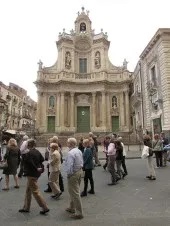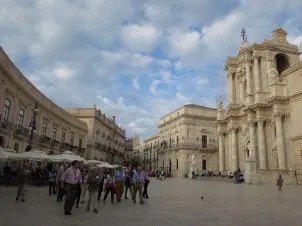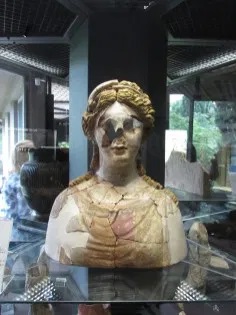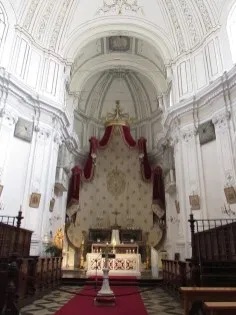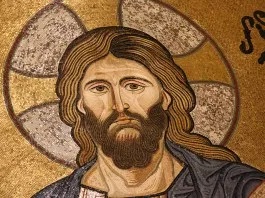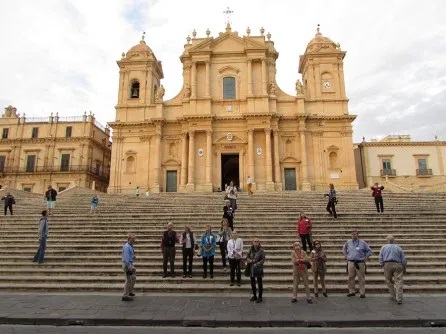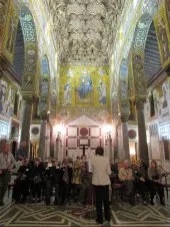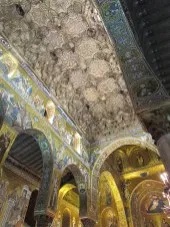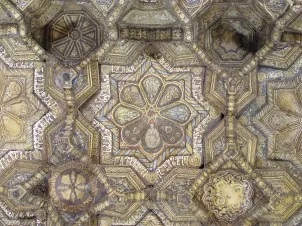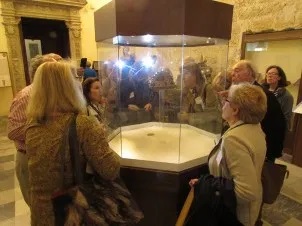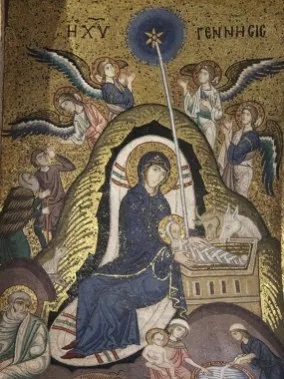The Decorative Arts Trust in Sicily

Although now politically linked to Italy, it’s closest geographical neighbor, Sicily has a long and diverse history as a melting pot of Mediterranean cultures. Much of the art and architecture reflect these influences from eastern and western Europe, North Africa, and the Middle East, and oftentimes a single structure serves as a visual record of millennia of Sicily’s history. It would be impossible to do adequate justice to the island in eight full days, but two groups of Trust members explored highlights of the provinces of Syracuse and Palermo, along with a long jaunt over the center of the island, stopping in Agrigento on the southern coast to take in some of the most spectacular classical ruins in Europe. Throughout the tour, we were treated to the hospitality, cuisine, and wine for which the island is justly admired.
The first three days of the trips focused on sites around Syracuse. As one of the foremost cities of the ancient world that maintained political control of the Magna Graecia regions of southern Europe, Syracuse features many vestiges of its successive building campaigns. Of particular note on the first day’s walking tour were the remains of the Temple of Apollo on the island of Ortigia (the oldest Doric temple in Sicily), and the Duomo, or Cathedral, which incorporates elements of the 6th-century BC Temple of Athena into its structure. The Greek and Roman amphitheaters just outside of the city were some of the largest ever built in the ancient world, and still see use today.
During this first portion of the tour, the groups were welcomed into two fantastic private residences, the Case del Biviere near Lentini, with it’s noted gardens, and the Palazzo Biscari, in Catania, where they were met by Kathleen Bennett, a Trust member who is researching the Palazzo’s baroque interiors, including the stunning Bird Gallery.
The last day in the province of Syracuse took the Trust further afield, exploring the baroque grandeur of Ragusa Ibla in the morning. Settlements in this location date back four millennia, but like many metropolitan centers in Sicily, much of the original fabric was decimated by earthquakes over the years. The turn of the 18th century in particular was a period of intense geological activity in Sicily, and many cities, including Ragusa, endured widespread destruction during a particularly powerful earthquake in 1693. Ragusa was rebuilt, and most of the glorious baroque structures erected in that campaign, including the church of San Giorgio, provide a charming vista. Of course, not all of the pleasures of Sicily are composed of stone or wood. The afternoon included a tour of the Bonajuto Chocolate Laboratory in Modica, the oldest chocolate factory in Sicily, whose recipes closely replicate those brought over by the Spaniards during their conquest of Sicily, who in turn had learned it from the Aztecs.
The next day, the group left Syracuse for Agrigento, stopping to explore the museums in Aidone and the Villa Romana. Built on the site of an older structure in the 4th century A.D., the Villa Romana contains the largest and most sophisticated group of intact Roman mosaics in the world, depicting leisure pursuits such as athletics, hunting, and collecting exotic animals. That evening, the group arrived in Agrigento on Sicily’s southern coast. The spectacular Hotel Villa Athena overlooked the town’s foremost landmark, the Valley of the Temples. Dinner at the hotel took place outside, providing a matchless view of the illuminated Temple of Concordia.
The stay in Agrigento proved to be one of the highlights of the trip, with a morning tour of the Valley of the Temples. The name is something of a misnomer, as all the structures are actually located on a rocky ridge below the city. Many of the temples date from the 5th century B.C., although other structures such as the Tomb of Theron may be a couple of centuries younger. The Doric Temple of Concordia, which remains in a remarkable state of preservation, is widely considered to be one of the foremost examples of ancient Greek architecture, and serves as the (loose) inspiration for UNESCO’s logo.
After a delicious lunch at Case Vecchie with chef Fabrizia Lanza, the Trust travellers arrived in Palermo, in time for a private evening tour of the Cappella Palatina in the city’s Palazzo Reale. The glowing golden mosaics, recently restored, date from the twelfth century A.D., bear strong influences of Byzantine architecture and art and were likely wrought by craftsmen from Constantinople. Indeed, many of the mosaics depict early church fathers hailed by both the Roman Catholic and Eastern Orthodox churches, although the political machinations of the chapel’s patron, the Norman King Roger II, frequently put him at odds with both Rome and the Byzantine Empire.
The following day started out with a walking tour of some of Palermo’s renowned churches, including the Orthodox church La Martorana, whose interior encompasses a variety of decorative styles from its fantastic Byzantine golden mosaics to neoclassical frescoes, and baroque splendor of the Church of Santa Caterina.
The next day saw the Trust going further afield, beginning with the Villa Malfitano, the home of Sicilian wine mogul and renowned ornithologist Joseph Whitaker, continuing to visit American expat and Sicilian cuisine guru Mary Simeti, before ending with a private evening visit to the magnificent Monreale Duomo. One of the foremost extant examples of Norman architecture, the cathedral was built by Roger II’s grandson, William II. Its exterior is richly carved and inlaid in the delicate Medieval style, while the interior houses the longest cycle of Byzantine mosaics found in Italy.
The final day of the tour brought the group to Palermo’s Duomo, with visits to the royal tombs and the treasury, which displays one of the great treasures of Byzantine costume, the Crown of Constance, one of the items this Queen of Sicily and Holy Roman Empress was wearing when she was interred in Palermo Cathedral in 1222. This was followed by the Oratory of Santa Cita, entirely decorated with the exuberant stucco work of Giacomo Serpotta, a true genius for this form of sculptural ornamentation.
2015 has proven to be a banner year for the Trust, and these back-to-back expeditions to Sicily cap off a year of sold-out international tours, including the spring trip to Germany, popular symposia in Chicago and Maine, new programming, and a reinvigorated website and online presence. It has been a pleasure accompanying Trust members on these excursions, and we hope participants will continue to share favorite memories and sites in the comments below. We look forward to an equally busy and exciting year in 2016!
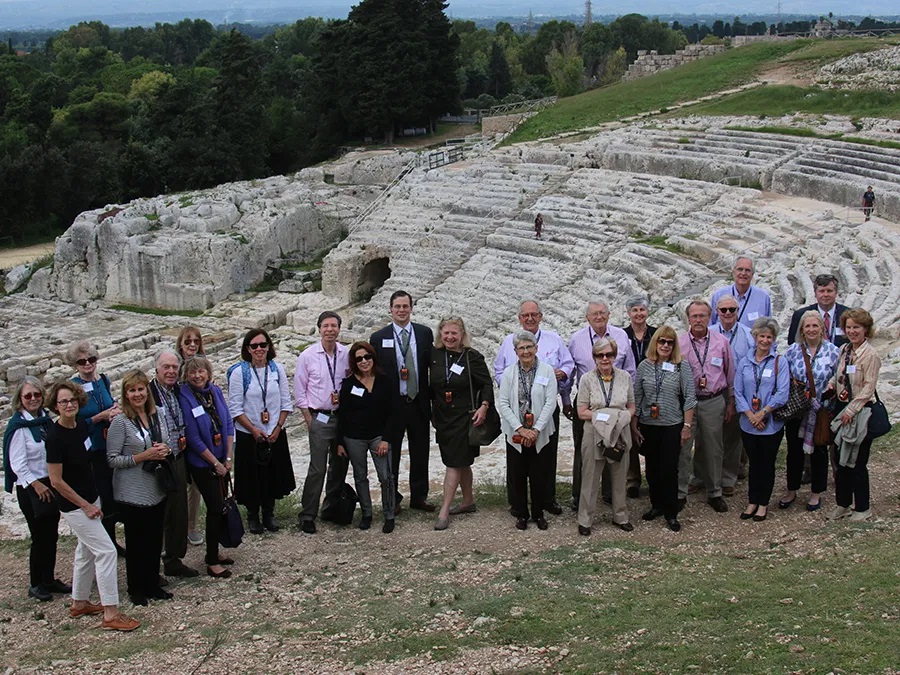
About The Decorative Arts Trust Bulletin
Formerly known as the "blog,” the Bulletin features new research and scholarship, travelogues, book reviews, and museum and gallery exhibitions. The Bulletin complements The Magazine of the Decorative Arts Trust, our biannual members publication.









